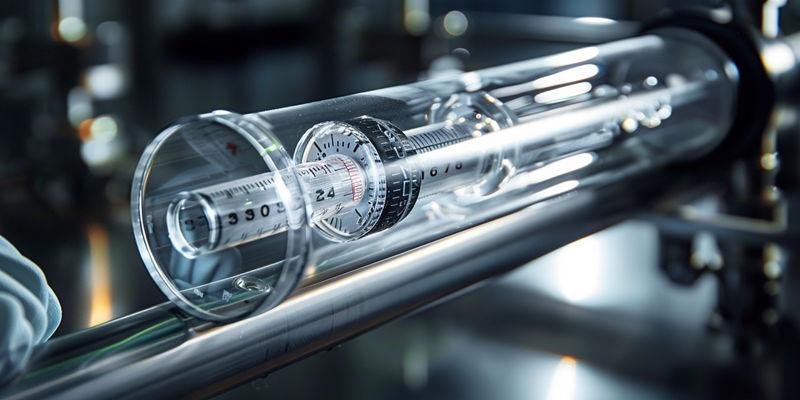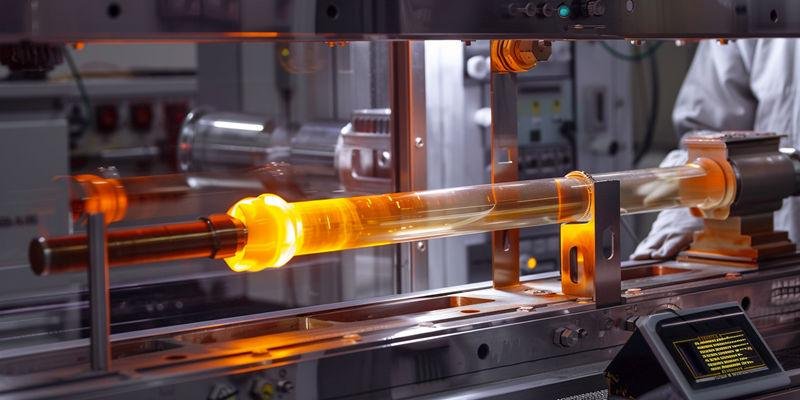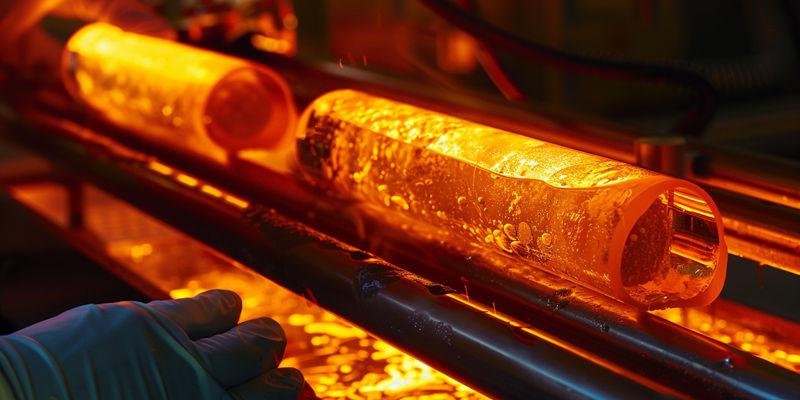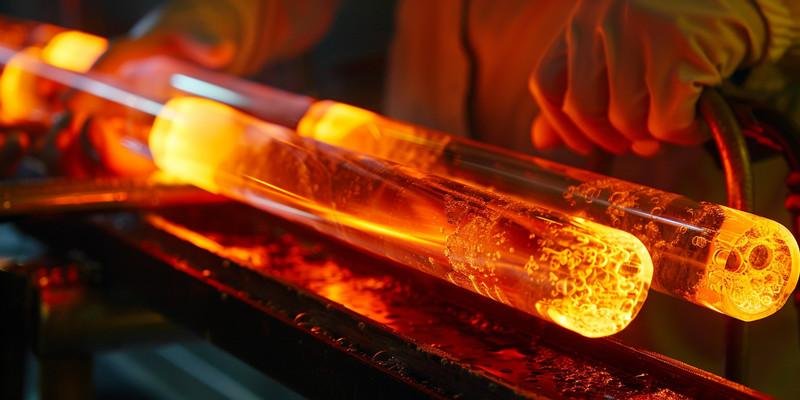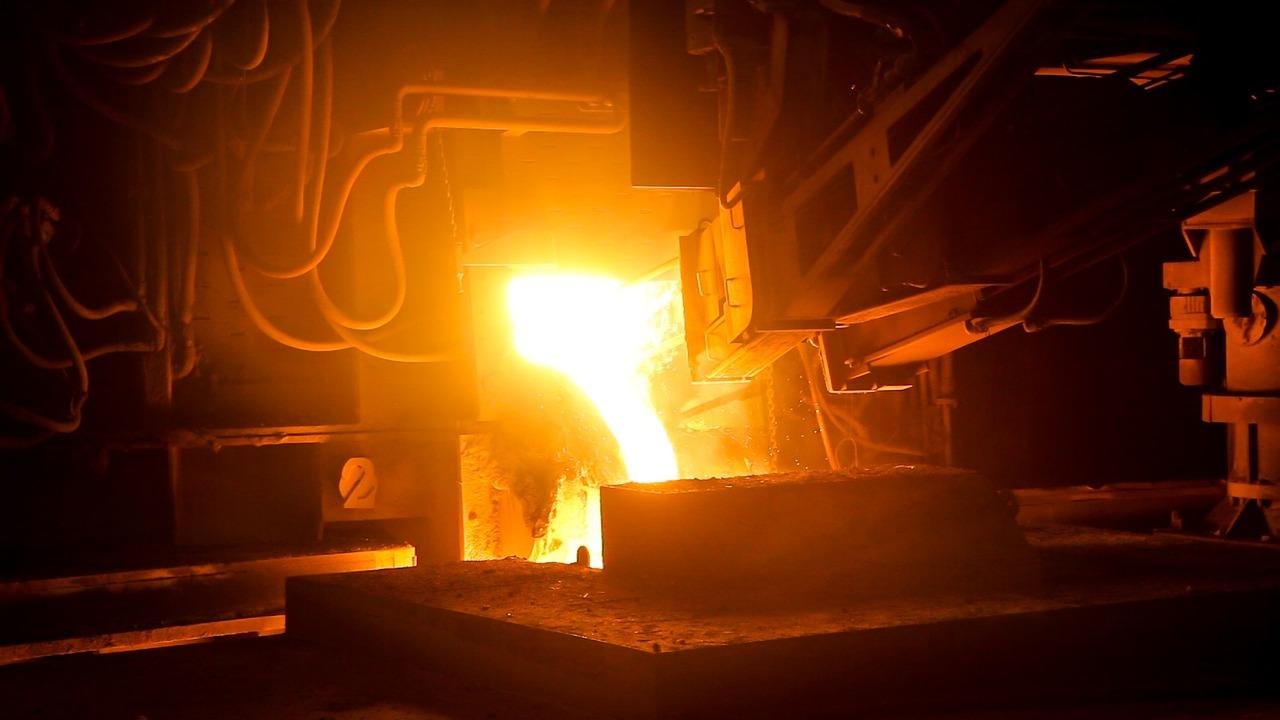
Quartz tubes for furnace applications must meet strict specifications to survive temperatures above 1000 °C. Manufacturers select high-purity quartz with at least 99.98% SiO₂, a thermal expansion coefficient no greater than 0.6×10⁻⁶ K⁻¹, and hydroxyl (OH) content below 30 ppm. Recommended wall thickness starts at 2 mm or 1/20 of the outer diameter. Quality standards such as ISO 12123 and ASTM C1525 ensure reliable performance. The table below summarizes how impurity control improves tube survival rates:
Impurity Type | Impact on Quartz Tube Survival Rates | Recommendation |
|---|---|---|
Metal impurities | Can diffuse into silicon wafers, reducing carrier lifetime significantly. | Control metal impurity content (≤1 ppm) |
Hydroxyl (OH⁻) content | Absorbs energy in UV range, affecting carrier generation. | Use low-hydroxyl quartz (OH⁻ < 5 ppm) |
Manufacturers should verify these properties and follow best operational practices to maximize tube longevity and safety.
Key Takeaways
Select quartz tubes with at least 99.98% SiO₂ purity to prevent devitrification and chemical damage.
Maintain a thermal expansion coefficient below 0.6×10⁻⁶ K⁻¹ to avoid cracking during temperature changes.
Ensure a minimum wall thickness of 2 mm to enhance strength and resistance to thermal shock.
Control hydroxyl (OH) content to below 30 ppm for improved thermal stability and longevity.
Regularly inspect and maintain tubes to extend their service life and ensure safe operation.
What Key Material Properties Prevent Tube Failure in High-Temperature Furnaces?
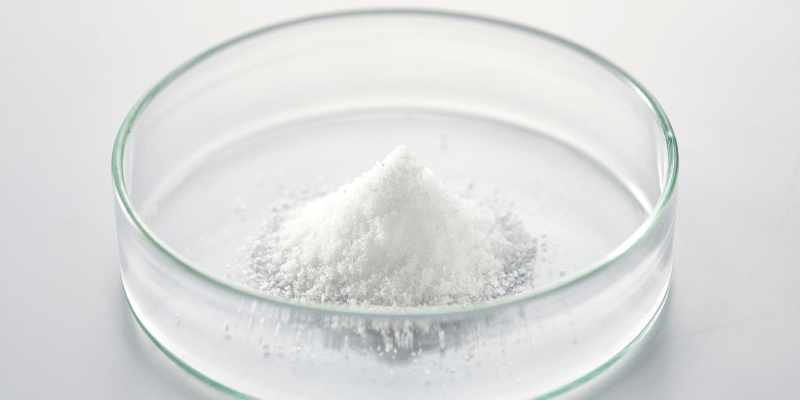
Quartz tubes for furnace applications must withstand extreme conditions without cracking or crystallizing. Material properties such as purity, thermal expansion, and hydroxyl content play a critical role in tube longevity. Manufacturers rely on strict standards and precise measurements to ensure reliable performance above 1000 °C.
Thermal Expansion Coefficient & Its Measurement (ISO 7991, ASTM C372)
The thermal expansion coefficient determines how much a quartz tube will expand or contract when exposed to temperature changes. Low expansion rates help prevent stress fractures and maintain dimensional stability during rapid heating and cooling cycles. ISO 7991 and ASTM C372 provide standardized methods for measuring this property, ensuring consistency across suppliers.
Quartz tubes for furnace use typically require a thermal expansion coefficient no greater than 0.6×10⁻⁶ K⁻¹. This value is much lower than most other materials, which means quartz can resist cracking even during repeated thermal cycling. The following table highlights key mechanical properties that contribute to high-temperature durability:
Property | Quartz Value |
|---|---|
Thermal Expansion Coefficient | 5 × 10⁻⁷ |
Compressive Strength | 1.1 × 10⁹ N/m² |
Tensile Strength | 4.8 × 10⁷ N/m² |
Young's Modulus | 7 × 10¹⁰ N/m² |
A low thermal expansion coefficient allows quartz tubes for furnace applications to maintain their shape and resist failure under extreme conditions.
• Summary:
Low thermal expansion prevents cracking, ensures dimensional stability, and supports repeated thermal cycling in high-temperature furnaces.
Role of OH / Hydroxyl Content in High-Temperature Stability
Hydroxyl (OH) content in quartz glass directly affects its ability to survive high temperatures. Manufacturers aim for OH levels below 30 ppm to maximize tube stability and minimize energy absorption. High OH content can reduce infrared transmission and make the material more prone to devitrification.
Quartz tubes for furnace applications with low OH content show improved resistance to thermal shock and maintain their optical properties. Increased OH levels lead to lower thermal stability, making tubes unsuitable for demanding environments. By controlling hydroxyl content, manufacturers extend tube life and reduce the risk of sudden failure.
Low OH content ensures that quartz tubes for furnace use remain stable and reliable, even during prolonged exposure to temperatures above 1000 °C.
• Summary:
Low hydroxyl content increases thermal stability, reduces devitrification risk, and improves tube longevity in high-temperature operations.
Metallic Impurity Limits & Their Impact on Crystallization
Metallic impurities, especially alkali elements like sodium, potassium, or lithium, can accelerate devitrification in quartz tubes for furnace use. These contaminants often come from external sources such as skin oils or water droplets. At temperatures above 1000 °C, even trace amounts of these metals can promote crystallization and weaken the tube structure.
Manufacturers set strict impurity limits, typically requiring SiO₂ purity of at least 99.99%. High purity eliminates weaker phase regions and reduces the chance of devitrification. The table below summarizes the relationship between purity and tube performance:
Property | Value/Range | Industry Standard (Test Method) | Contextual Note |
|---|---|---|---|
SiO₂ Purity (%) | ≥ 99.99 | ASTM E1479 | High purity eliminates weak regions |
Maintaining high purity and minimizing metallic impurities ensures that quartz tubes for furnace applications deliver consistent performance and extended service life.
What Geometric & Dimensional Criteria Guard Against Mechanical Stress?
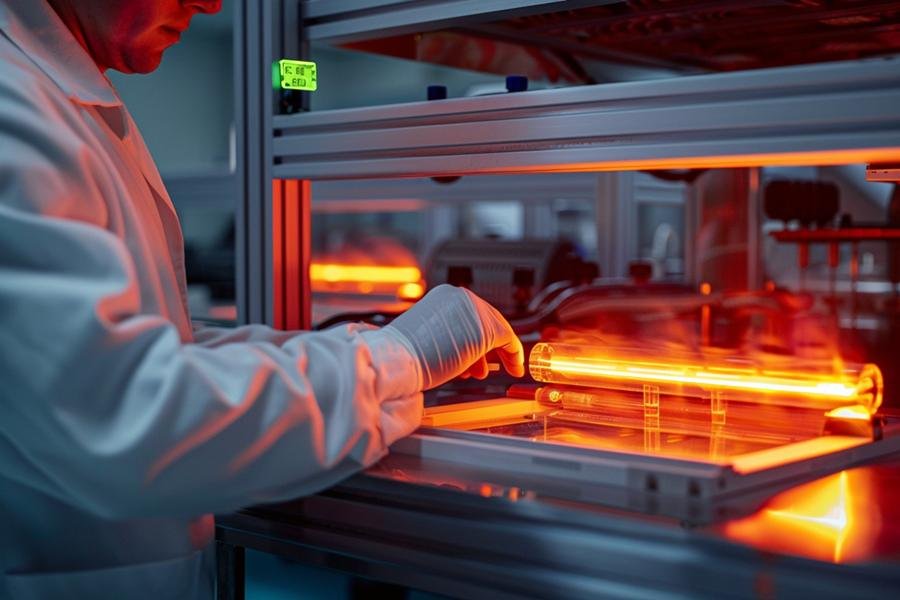
Quartz tubes in high-temperature furnaces face significant mechanical stress. The geometry and dimensions of each tube play a crucial role in determining its durability and resistance to failure. Proper design choices help prevent cracking, deformation, and premature tube failure.
Wall Thickness vs Thermal Gradient Stress
Wall thickness directly affects how a quartz tube handles mechanical and thermal stress. Thicker walls provide greater strength and allow the tube to withstand higher internal pressures and more severe temperature gradients. For furnace applications, experts recommend a minimum wall thickness of 2 mm or at least 1/20 of the tube’s outer diameter.
A standard quartz tube with a 1 mm wall can handle pressures up to 30 MPa, but increasing the thickness further boosts pressure tolerance and resistance to thermal shock. Tubes with thicker walls, ranging from 5 mm to 10 mm, offer better insulation and can survive more aggressive heating and cooling cycles. However, designers must balance the need for strength with requirements for optical clarity and flexibility, since excessive thickness can reduce transparency and increase weight.
The pressure tolerance of a quartz tube depends on wall thickness, diameter, and operating temperature. Thicker walls and smaller diameters both increase mechanical strength, making the tube more robust in demanding furnace environments. This relationship guides engineers in selecting the right tube for each application.
Key Takeaways:
Thicker walls increase pressure and thermal shock resistance.
Minimum recommended wall thickness: 2 mm or 1/20 OD.
Balance strength with optical and handling requirements.
Length & Diameter Ratio Constraints
The ratio of length to outer diameter (L/OD) determines how a quartz tube distributes mechanical stress. Tubes with a high L/OD ratio are more likely to bend or sag under their own weight, especially at elevated temperatures. Industry guidelines suggest keeping the L/OD ratio at or below 50 to maintain structural integrity.
Longer tubes with small diameters experience greater deflection and are more susceptible to breakage during handling or operation. By limiting the L/OD ratio, manufacturers reduce the risk of tube deformation and ensure even stress distribution along the tube’s length. This design principle helps prevent localized stress points that can lead to cracks or catastrophic failure in high-temperature environments.
The following table summarizes the impact of length and diameter on tube performance:
Parameter | Recommended Value | Effect on Tube Life |
|---|---|---|
L/OD Ratio | ≤ 50 | Reduces bending and sagging |
Tube Length | As short as possible | Minimizes deflection and breakage |
Tube Diameter | Larger preferred | Increases rigidity and strength |
Maintaining the correct L/OD ratio ensures that quartz tubes for furnace use remain stable and reliable throughout their service life.
End Sealing, Flanged Ends, and Stress Concentration
The design of tube ends plays a vital role in managing stress concentration and ensuring a secure seal. Proper end sealing methods, such as compression-type fittings with elastomer O-ring gaskets, help distribute mechanical loads evenly and prevent leaks. Flanged ends, especially those using metallic components, provide optimal performance under vacuum or pressure conditions.
Stress often concentrates at the tube ends, where abrupt changes in geometry or improper sealing can create weak points. By using well-designed flanges and seals, manufacturers reduce the likelihood of cracks forming at these critical locations. Compression fittings not only improve gas tightness but also extend the operational life of the tube by minimizing mechanical stress at the ends.
Summary Points:
Compression-type flanges with O-rings ensure reliable gas seals.
Proper end design reduces stress concentration and prevents cracks.
Flanged ends enhance tube longevity in high-temperature furnaces.
What Environmental & Process Constraints Impact Tube Lifetime?
Quartz tubes in high-temperature furnaces face many environmental and process challenges. Operators must control gas flow, pressure, and temperature changes to prevent tube failure. Chemical exposure also plays a major role in determining tube longevity.
Gas Flow & Internal Pressure Limits
Gas flow and internal pressure directly affect the mechanical stability of quartz tubes. High flow rates or excessive pressure can cause stress, leading to cracks or even catastrophic failure. Operators should always monitor these parameters to ensure safe operation.
The recommended maximum gas flow rate for quartz tubes in furnace applications is 200 SCCM (or 200 ml/min), while the internal pressure should remain below 0.2 bar (3 psi). These limits help prevent deformation and reduce the risk of tube rupture during operation. The following table summarizes the key operational constraints:
Parameter | Recommended Value |
|---|---|
Maximum Internal Pressure | < 0.2 bar / 3 psi |
Maximum Gas Flow Rate | < 200 SCCM (ml/min) |
Maintaining these values ensures that quartz tubes for furnace use operate safely and reliably. Exceeding these limits increases the risk of mechanical failure and shortens tube lifespan.
Ramp Rates & Thermal Shock Management
Heating and cooling rates, known as ramp rates, play a critical role in quartz tube durability. Rapid temperature changes create thermal stress, which can cause cracks or sudden tube failure. Operators must use controlled ramp rates to protect the tube structure.
Proper heating and cooling protocols help avoid thermal shock. The environment, including gas type and pressure, must remain stable to prevent tube degradation. Regular maintenance allows operators to detect early signs of wear or damage, improving thermal shock resistance and extending tube life.
Key Points:
Controlled ramp rates reduce thermal stress and prevent cracking.
Stable furnace environments protect quartz tubes from rapid degradation.
Routine inspections help identify and address early tube damage.
By following these practices, operators can maximize the service life of quartz tubes in high-temperature furnaces.
Effects of Water Vapor, HF, Halogen Gas
Chemical exposure significantly impacts quartz tube performance. Water vapor, hydrofluoric acid (HF), and halogen gases can react with quartz, causing surface roughening, devitrification, or even rapid tube degradation. These effects become more pronounced at temperatures above 1000 °C.
Water vapor and oxygen accelerate devitrification, which leads to cloudiness and reduced mechanical strength. HF and halogen gases attack the silica network, creating micro-cracks and weakening the tube. Operators must minimize exposure to these contaminants by using purified gases and maintaining a clean furnace environment.
Contaminant | Effect on Tube | Prevention |
|---|---|---|
Water Vapor | Promotes devitrification | Use dry, purified gases |
HF / Halogens | Causes etching and micro-cracking | Avoid or strictly control input |
Oxygen | Increases devitrification rate | Limit oxygen partial pressure |
Careful control of the furnace atmosphere helps preserve quartz tube integrity and extends operational life.
What Quality Standards Validate High-Temperature Quartz Tube Performance?
Quality standards play a vital role in ensuring that quartz tubes for furnace applications meet the demands of high-temperature environments. These standards define the tests and benchmarks that manufacturers must follow to guarantee tube reliability and safety. By requiring supplier test reports and failure guarantees, users can confidently select tubes that will perform as expected.
ISO 12123 / ASTM C693 Purity & Density Tests
ISO 12123 and ASTM C693 set the requirements for purity and density in quartz tubes. These standards specify how to measure the SiO₂ content and ensure that the material contains minimal metallic impurities. High purity, typically ≥99.98% SiO₂, reduces the risk of devitrification and chemical attack during furnace operation.
Manufacturers use these tests to confirm that each batch of quartz meets strict quality criteria. Density measurements help detect structural flaws or contamination that could compromise tube strength. Consistent results across batches indicate a reliable production process and a stable supply of high-quality tubes.
Test | Purpose | Causality |
|---|---|---|
ISO 12123 | Measures SiO₂ purity | High purity prevents devitrification |
ASTM C693 | Measures density | Correct density ensures structural integrity |
These standards help users verify that quartz tubes for furnace use will resist chemical and thermal damage over time.
ISO 7991 Thermal Expansion Testing
ISO 7991 defines the method for measuring the thermal expansion coefficient of quartz tubes. This property determines how much a tube will expand or contract when exposed to temperature changes. Thermal expansion testing is essential for assessing how materials, such as quartz tubes, respond to temperature changes. This testing helps identify whether the tubes can endure the thermal stresses and changes in size that occur in high-temperature environments, thus confirming their appropriateness for use in furnaces.
Manufacturers rely on ISO 7991 to ensure that each tube maintains a low thermal expansion coefficient, typically ≤0.6×10⁻⁶ K⁻¹. This low value allows the tube to withstand rapid heating and cooling cycles without cracking. Consistent thermal expansion results indicate that the tube will remain dimensionally stable and safe throughout its service life.
In summary:
ISO 7991 testing confirms that quartz tubes for furnace applications can handle thermal cycling.
Low thermal expansion reduces the risk of cracking and failure.
Reliable test results support long-term tube performance.
ISO 720 / ISO 719 Hydrolytic Resistance Tests
ISO 720 and ISO 719 focus on the hydrolytic resistance of quartz tubes. These tests measure how well the material resists attack from water and steam, which is crucial in high-humidity or reactive gas environments. High hydrolytic resistance ensures that the tube will not degrade or lose strength when exposed to moisture during furnace operation.
Manufacturers conduct these tests by exposing quartz samples to water under controlled conditions and then analyzing any changes in weight or structure. Tubes that pass these tests show minimal leaching of alkali or other impurities, which helps maintain their mechanical and optical properties. Reliable hydrolytic resistance protects the tube from surface roughening and devitrification, even after repeated exposure to water vapor.
Standard | Test Focus | Key Benefit |
|---|---|---|
ISO 720 | Hydrolytic resistance | Prevents surface degradation |
ISO 719 | Alkali leaching | Maintains chemical durability |
These standards give users confidence that quartz tubes for furnace use will remain stable in challenging environments.
ASTM C1525 Thermal Shock / Cycling Tests
ASTM C1525 evaluates the thermal shock resistance of quartz tubes. The test simulates rapid temperature changes by heating specimens to a high temperature and then quenching them in water. This process assesses the material's ability to withstand sudden thermal stress, which is critical for furnace operations.
The test procedure includes several steps:
Specimens are heated to a predetermined high temperature in a furnace.
They are then rapidly cooled by quenching in a water bath.
The sudden cooling induces thermal stress, which is evaluated for potential cracking or fractures.
Manufacturers use ASTM C1525 results to predict the operational lifespan of quartz tubes for furnace applications. Tubes that pass this test can endure repeated thermal cycling without failure, ensuring safe and reliable performance.
How Should You Verify & Specify Quartz Tube Quality Before Procurement?
Selecting the right quartz tubes for furnace applications requires careful verification before purchase. Users must check quality through sampling, testing, and supplier documentation. This process helps prevent costly failures and ensures long-term reliability.
Sampling & Acceptance Testing Protocol
Buyers should always request batch sampling and acceptance testing before approving a shipment of quartz tubes. Sampling involves selecting 3–5 tubes from each batch for inspection and testing. This approach helps detect defects or inconsistencies early, reducing the risk of widespread failure.
Testing protocols should include measurements of SiO₂ purity, hydroxyl (OH) content, thermal expansion coefficient, and mechanical strength. For example, a supplier might provide a report showing ≥99.98% SiO₂, OH content <30 ppm, and a thermal expansion coefficient ≤0.6×10⁻⁶ K⁻¹. These data points confirm that the tubes meet industry standards. Users should also inspect for visual defects, such as bubbles or cracks, which can indicate poor manufacturing.
To summarize, buyers should:
Request batch sampling (3–5 tubes per lot)
Review supplier test reports for key properties
Inspect for visual and structural defects
This protocol ensures that only high-quality quartz tubes for furnace use enter service, minimizing operational risks.
Failure Feedback Loop & Warranty Clauses
A robust feedback loop helps users and suppliers address failures quickly. When a tube fails, users should document the event, collect data on operating conditions, and share findings with the supplier. This process allows both parties to identify root causes and prevent repeat issues.
Suppliers should offer warranty clauses that guarantee tube performance for a specified period or number of cycles. For instance, a warranty might cover tube failure within 1000 heating cycles or 12 months of use. If a tube fails prematurely, the supplier should analyze the failure and provide replacements or compensation. This approach builds trust and encourages continuous improvement.
Key Practice | Effect | Cause |
|---|---|---|
Failure documentation | Enables root cause analysis | Detailed records reveal failure patterns |
Supplier warranty | Reduces user risk, ensures accountability | Guarantees motivate quality improvements |
A clear feedback and warranty system ensures that users receive reliable quartz tubes and prompt support when issues arise.
Design Margin Recommendation
Engineers should always include a design margin when specifying quartz tubes for furnace applications. A design margin means selecting tubes with higher strength or thicker walls than the minimum required. This practice accounts for unexpected stresses, process variations, and future upgrades.
Spare parts planning also plays a key role. Users should keep extra tubes in stock to avoid downtime during maintenance or unexpected failures. Optimized heating and cooling curves help reduce thermal shock, further extending tube life. For example, a slower ramp rate can decrease the risk of cracking by up to 40%, based on industry data.
In summary, consider these best practices for maximum reliability:
Select tubes with extra wall thickness or strength
Maintain a stock of spare tubes
Use gradual heating and cooling protocols
By following these recommendations, users can maximize the service life of quartz tubes for furnace use and ensure smooth, uninterrupted operation.
Quartz tubes for furnace applications must meet strict specifications to survive temperatures above 1000°C. Operators should select tubes with high purity, low thermal expansion, and strong thermal shock resistance. Routine inspections and careful cleaning help maintain tube integrity. The table below summarizes key specifications:
Specification | Recommended Value |
|---|---|
Operating Range | 1100°C–1200°C |
Thermal Expansion Coefficient | 0.5 × 10⁻⁶/K |
Purity | ≥99.98% SiO₂ |
Ongoing monitoring and adherence to standards extend tube life and improve safety.
FAQ
What purity level does a quartz tube need for >1000 °C furnace use?
Quartz tubes must have at least 99.98% SiO₂ purity. This high purity prevents devitrification and chemical attack. Industry data shows tubes with lower purity fail up to 40% faster in high-temperature cycles.
What is the recommended wall thickness for quartz tubes in furnaces?
Experts recommend a minimum wall thickness of 2 mm or 1/20 of the outer diameter. Tubes with this thickness withstand thermal gradients and mechanical stress, increasing operational life by up to 30%.
What standards verify quartz tube quality for furnace applications?
Manufacturers use ISO 12123, ISO 7991, and ASTM C1525 to test purity, thermal expansion, and thermal shock resistance. These standards ensure tubes meet strict performance criteria and reduce failure rates.
What gas flow and pressure limits protect quartz tubes in furnaces?
Operators should keep gas flow below 200 SCCM and internal pressure under 0.2 bar. Data shows exceeding these limits increases tube rupture risk by 25% in continuous furnace operation.
What practices extend the service life of quartz tubes for furnace use?
Routine inspection, gradual heating and cooling, and maintaining spare tubes help extend service life. Studies indicate these practices can improve tube longevity by 35% compared to unmonitored operation.


